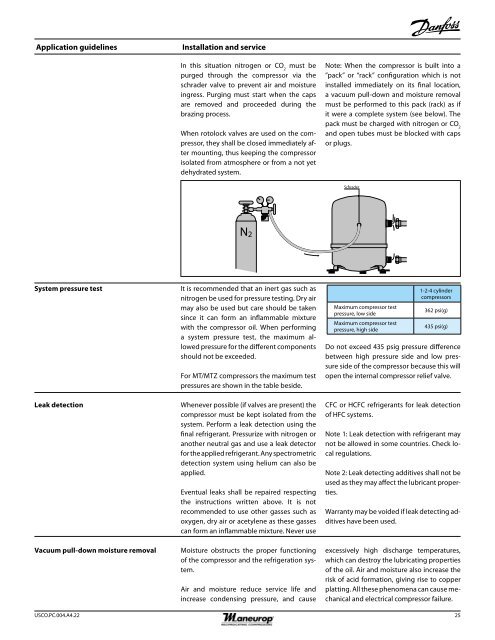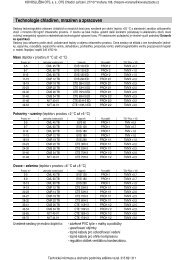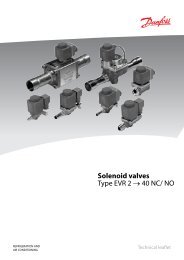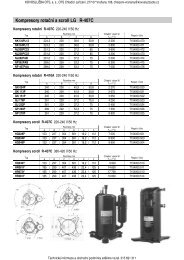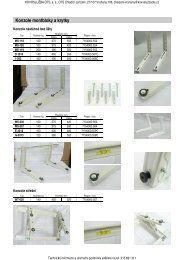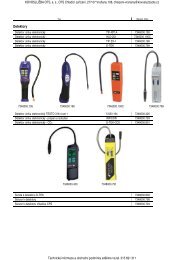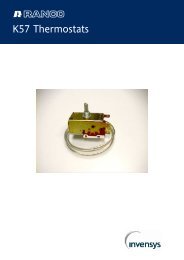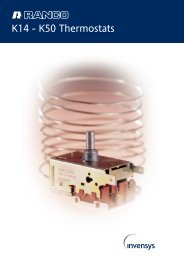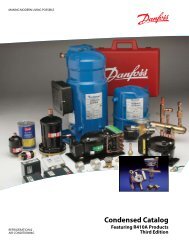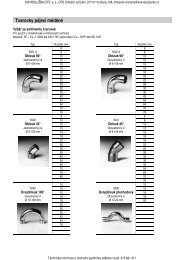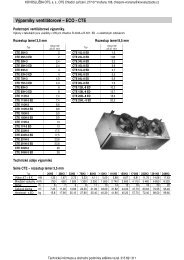Maneurop® reciprocating compressors
Maneurop® reciprocating compressors
Maneurop® reciprocating compressors
You also want an ePaper? Increase the reach of your titles
YUMPU automatically turns print PDFs into web optimized ePapers that Google loves.
Application guidelines<br />
Installation and service<br />
In this situation nitrogen or CO 2<br />
must be<br />
purged through the compressor via the<br />
schrader valve to prevent air and moisture<br />
ingress. Purging must start when the caps<br />
are removed and proceeded during the<br />
brazing process.<br />
When rotolock valves are used on the compressor,<br />
they shall be closed immediately after<br />
mounting, thus keeping the compressor<br />
isolated from atmosphere or from a not yet<br />
dehydrated system.<br />
Note: When the compressor is built into a<br />
”pack” or “rack” configuration which is not<br />
installed immediately on its final location,<br />
a vacuum pull-down and moisture removal<br />
must be performed to this pack (rack) as if<br />
it were a complete system (see below). The<br />
pack must be charged with nitrogen or CO 2<br />
and open tubes must be blocked with caps<br />
or plugs.<br />
System pressure test<br />
Leak detection<br />
Vacuum pull-down moisture removal<br />
It is recommended that an inert gas such as<br />
nitrogen be used for pressure testing. Dry air<br />
may also be used but care should be taken<br />
since it can form an inflammable mixture<br />
with the compressor oil. When performing<br />
a system pressure test, the maximum allowed<br />
pressure for the different components<br />
should not be exceeded.<br />
For MT/MTZ <strong>compressors</strong> the maximum test<br />
pressures are shown in the table beside.<br />
Whenever possible (if valves are present) the<br />
compressor must be kept isolated from the<br />
system. Perform a leak detection using the<br />
final refrigerant. Pressurize with nitrogen or<br />
another neutral gas and use a leak detector<br />
for the applied refrigerant. Any spectrometric<br />
detection system using helium can also be<br />
applied.<br />
Eventual leaks shall be repaired respecting<br />
the instructions written above. It is not<br />
recommended to use other gasses such as<br />
oxygen, dry air or acetylene as these gasses<br />
can form an inflammable mixture. Never use<br />
Moisture obstructs the proper functioning<br />
of the compressor and the refrigeration system.<br />
Air and moisture reduce service life and<br />
increase condensing pressure, and cause<br />
Maximum compressor test<br />
pressure, low side<br />
Maximum compressor test<br />
pressure, high side<br />
1-2-4 cylinder<br />
<strong>compressors</strong><br />
362 psi(g)<br />
435 psi(g)<br />
Do not exceed 435 psig pressure difference<br />
between high pressure side and low pressure<br />
side of the compressor because this will<br />
open the internal compressor relief valve.<br />
CFC or HCFC refrigerants for leak detection<br />
of HFC systems.<br />
Note 1: Leak detection with refrigerant may<br />
not be allowed in some countries. Check local<br />
regulations.<br />
Note 2: Leak detecting additives shall not be<br />
used as they may affect the lubricant properties.<br />
Warranty may be voided if leak detecting additives<br />
have been used.<br />
excessively high discharge temperatures,<br />
which can destroy the lubricating properties<br />
of the oil. Air and moisture also increase the<br />
risk of acid formation, giving rise to copper<br />
platting. All these phenomena can cause mechanical<br />
and electrical compressor failure.<br />
USCO.PC.004.A4.22 25


